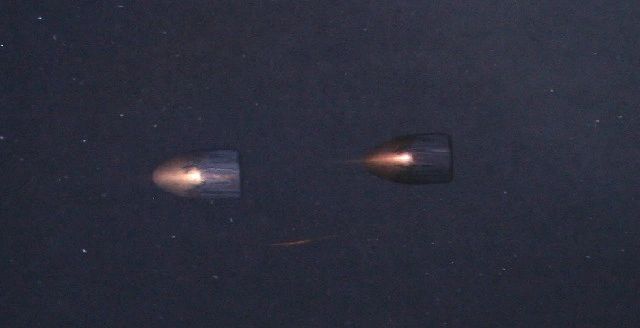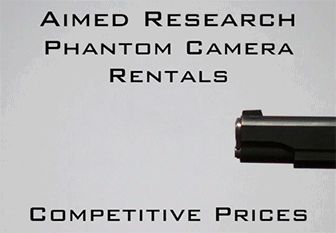Low-Priced High-Speed Camera Options
If our rental options of hundreds of dollars per day for 1 Million FPS Phantom and Photron 2K Camera performance or Fastec TS3Cine prices of $100-$150 per day are out of your budget, we would still like to assist you in finding a suitable camera for your application. Aimed Research has investigated many of the high-speed consumer cameras on the market and stays current on the available used market for entry-level to mid-level professional cameras.
Below are a few consumer high-speed cameras commonly available at varying price brackets.
Sony RX10 III
There seems to be a new pace setter for consumer high-speed cameras, Sony that is. Sony has a few models of RX cameras, the Sony RX10 and Sony RX100. The high-speed functions are the same for the RX10 and RX100 models: 1136x384 @ 1,000fps. Unfortunately it will only record at this speed for 2 seconds. Higher resolutions are available. The Sony RX10 III has just hit the market, so watch for deals as well as real consumer reviews.
Check out this video of the Sony RX100 IV against the iPhone 6s Plus and a Vision Research Phantom Miro LC320S. The clips went through post-processing for optimal results, pay attention to the unprocessed clips to see what you get without putting your work through editing software.
Casio Exilim EX-F1
To date, the Casio Exilim EX-F1 is still the best consumer option for the price. It has since been discontinued with no comparable replacement model from Casio. The Exilim EX-F1 has been controlled with MATLAB and other software programs for remote control and 3D analysis with multiple cameras. This camera is used for R&D by companies and laboratories around the world. Due to being a highly sought-after discontinued camera nearly all of them on the market are used. For years after being discontinued the original $999 MSRP was generally the lowest price you could find. Concerning only the high-speed video features, the Exilim EX-F1 records at 300fps (512x384), 600fps (432x192) and 1200fps (336x96) as MOV files with frame exposures up to 1/40,000 (Electronic Rolling Shutter) and a sensitivity of ISO1600. The maximum exposure speed is an important feature surpassing many other cameras in its price bracket. The EX-F1 uses SD memory cards; the high-speed video record duration is only limited by the space on the card, up to 4GB. Do not expect all consumer cameras to operate in this manner.
The Casio Exilim EX-F1's internal optics are fully enclosed. Many of the other cameras from the Exilim product line develop mechanical lens issues, but our experience using dozens of Casio Exilim EX-F1's has showed zero lens issues and only one known issue with a LCD display from rough handling.
Nikon 1 Series Cameras
The Nikon 1 cameras (J, S, V, and AW models) are unique in that they are similar in frame rate to the Casio Exilim EX-F1 but unlike the EX-F1 the user can use a variety of lenses, the Nikon 1 type. If you have expensive Nikon F-Mount lenses available, they'll mount to the Nikon 1 cameras with a FT-1 adapter. Most of the Nikon 1 cameras record at 400fps (640x240) and 1,200fps (320x120) as MOV files with frame exposures up to 1/16,000 and a sensitivity of ISO6400. The major disadvantange of these camera models is the record duration, they will only record for a few seconds regardless of the available space on the memory card unlike the Exilim EX-F1. The Nikon J, S, V, and AW cameras are identical in regard to high-speed video specifications, they only differ in regard to still photography and standard speed (24-60fps) video features.
The newest model such as the Nikon J5 has an EXPEED-5A engine allowing a slight increase in resolution at a given frame rate: 120fps (1280x720), 400fps (800x296), and 1,200fps (400x144). Additionally, the Nikon J5 will shoot in 4K (3840x2160) at 14.99fps.
According to our experience, the early models of these cameras (J1, etc.) develop issues that result in poor quality or corrupted video upon playback by computer but not on the camera's display. It is recommended that you purchase a new camera with a warranty. Some used models sold will be refurbished, though not disclosed as such.
The most affordable Nikon J1 model has been referenced below.
The EXPEED-5A engine Nikon J5 model has been referenced below.
GoPro Hero Series
The famed GoPro camera has high-speed video capability; though, the technology is more suited for high-resolution videos. The GoPro Hero4 Black Edition records 3840x2160 which is called 4K Resolution at 30fps, 1080HD at 120fps, oddly 720HD is also at 120fps, and the fastest resolution is WVGA 848x480 at 240fps. The available file formats are H.264 and mp4. The ISO settings for video are 6400, 1600, and 400. The GoPro Hero4 Black Edition has been referenced below.
The Slow Motion Camera Company FPS1000, FPS2000, and FPS4000
The FPS1000 was a high-speed camera that made its appearance on Kickstarter in 2014. The campaign resulted in the formation of The Slow Motion Camera Company which is now defunct. The designer, Graham Rowan, even demonstrated a 3D version. There were various models created with 720HD, 1080HD, and 4K image sensors. Considering the specs of the FPS1000, it will capture 1280x720 (720HD) at 1,000fps. There are more user-definable resolutions available. The camera came with software to control the camera through the USB3.0 port. The FPS1000 camera is C-mount and came with an inexpensive 35mm f/1.7 lens. The FPS2000 and FPS4000 models were sold with a Micro 4/3 mount potentially granting use of various speed boosters which reduce lens crop factor and increase light concentration on the pixels (with Nikon or Canon lenses for instance). The FPS1000 held a high-speed imaging niche of long record times up to 2 minutes with the 256GB model. The FPS1000 was the world's most affordable entry-level high-speed camera, yet maybe too affordable that the company went out of business with orders that never shipped.
Kron Technologies Chronos 1.4
One of the newest low-cost high-speed cameras is the Chronos 1.4 by David Kronstein - Kron Technologies, the man behind the tech YouTube channel Tesla500. David has tear-down and repair experience of past high-speed camera top-tier front-runners such as the Vision Research Phantom v5.0, Phantom v4.1, the Kodak Ektapro, the Redlake Motionscope, and counting. The Chronos 1.4 camera was first released on Kickstarter in 2016. The 1280x1024 camera has a full resolution frame rate of 1,057fps with frame rate increases at lower resolutions (1,500fps at 720HD, etc.). The DDR3 Ram is either 8GB, 16GB, or 32GB. Other features include standalone operation, touchscreen controls, dial control to easily scan through video similar to the Casio Exilim EX-F1, H.264 onboard compression, DNG Raw, USB, eSATA, and SD card storage. Their entry price point of about $3,000 (without lenses) has heralded a significant change in the professional high-speed, slow-motion camera market.
Sanstreak Corp. Edgertronic SC Series
Another high-speed camera to consider is the Edgertronic (Sanstreak Corp). Currently the SC1 model costs about $5,500; it certainly is faster than the Sony RX10 and RX100 cameras, Casio Exilim cameras, Nikon 1 cameras as well as the GoPro cameras. It accepts F-mount lenses (Nikon type), which are fairly expensive compared to the camera but the Nikon F-mount is the standard for professional 1MP high-speed cameras. The manufacturer is now a veteran to the industry - they found their start on Kickstarter and they advanced their cameras through various revisions. Currently they offer two model improvements, the SC2 and SC2+, starting at about $10,000 they are outside the scope of the term "consumer" high-speed cameras. Though yet untested by Aimed Reserach, the Edgertronic SC2 is comparable to the entry-level Vision Research Miro C110, with faster frame rates than the Fastec TS5 not to mention the TS4 and TS3, and a likely competitor to the hand-held Mega Speed cameras.
The Edgertronic SC series has recently entered the full 1080HD market with the SC2X which shoots 1,910fps at 1080HD. Like the SC2 and SC2+, the SC2X is not necessarily a low-priced option at nearly $16,000.
Another high-speed camera to consider is the Edgertronic (Sanstreak Corp). Currently the SC1 model costs about $5,500; it certainly is faster than the Sony RX10 and RX100 cameras, Casio Exilim cameras, Nikon 1 cameras as well as the GoPro cameras. It accepts F-mount lenses (Nikon type), which are fairly expensive compared to the camera but the Nikon F-mount is the standard for professional 1MP high-speed cameras. The manufacturer is now a veteran to the industry - they found their start on Kickstarter and they advanced their cameras through various revisions. Currently they offer two model improvements, the SC2 and SC2+, starting at about $10,000 they are outside the scope of the term "consumer" high-speed cameras. Though yet untested by Aimed Reserach, the Edgertronic SC2 is comparable to the entry-level Vision Research Miro C110, with faster frame rates than the Fastec TS5 not to mention the TS4 and TS3, and a likely competitor to the hand-held Mega Speed cameras.
The Edgertronic SC series has recently entered the full 1080HD market with the SC2X which shoots 1,910fps at 1080HD. Like the SC2 and SC2+, the SC2X is not necessarily a low-priced option at nearly $16,000.

Strobe effect of one 9mm projectile in flight using two 500 nanosecond flash units and a Canon Rebel. This type of photography is useful for yaw and rotation measurements and can be conducted with multiple cameras viewing at the exact same instant.
Content copyright 2021. Aimed Research, LLC. All rights reserved.
"Who fails his knowledge to increase is sure to see his knowledge cease."
-Hillel
-Hillel
